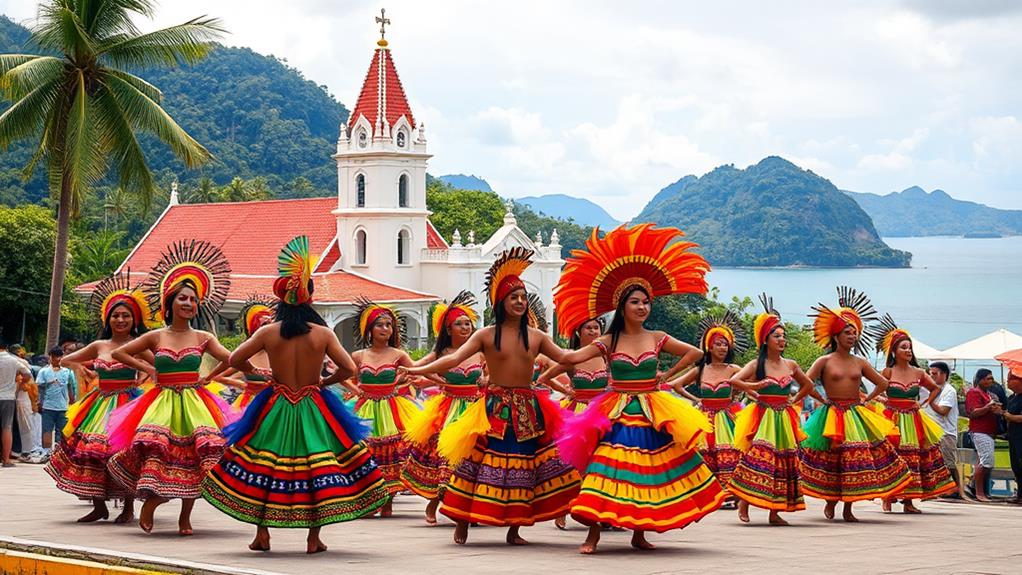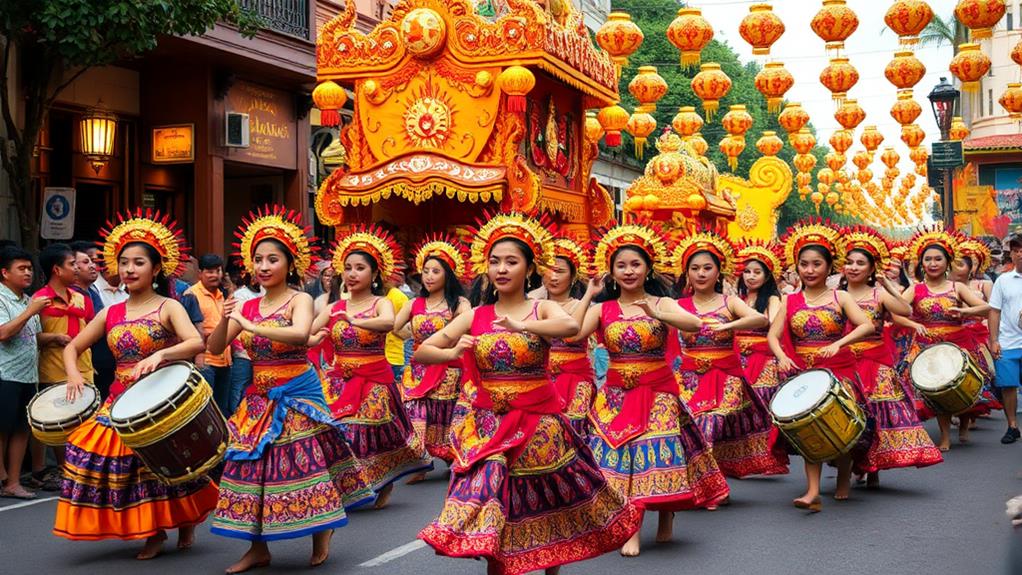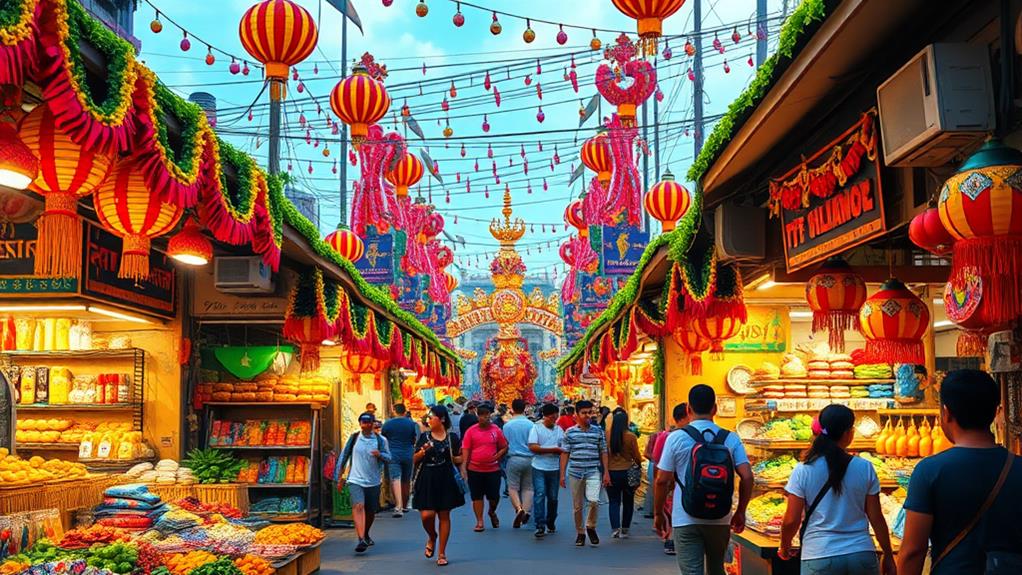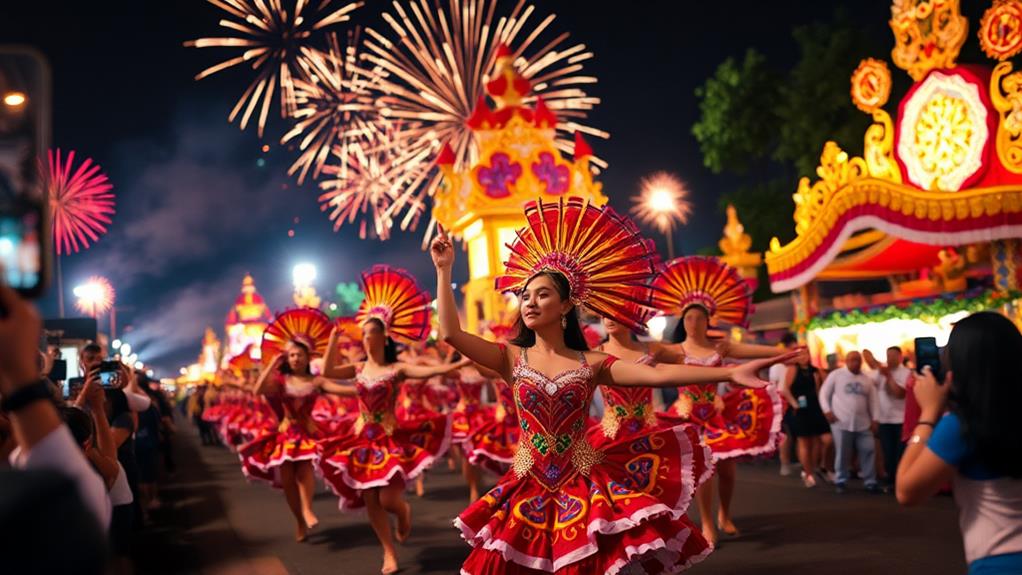The Philippines is home to a diverse range of unique festivals, with over 42,000 celebrations taking place annually. These festivals showcase the country's rich history, cultural heritage, and community spirit.
Some of the most notable festivals in the Philippines include those honoring Santo Niño, a representation of the Child Jesus, which is an integral part of the country's Catholic heritage. The Sinulog festival, for example, is a grand celebration of Santo Niño, featuring colorful street dancing and processions.
In addition to festivals honoring Catholic traditions, the Philippines also celebrates various agricultural practices and seasonal events. The blooming season, for instance, is marked by festivals that showcase the country's vibrant flora and fauna.
Harvest festivals, on the other hand, give thanks for the country's bountiful agricultural produce.
These festivals not only highlight the Philippines' diverse traditions but also demonstrate the country's infectious community spirit. Each festival offers a unique experience that reveals a new side of the nation.
Festivals Across the Philippines

The Philippines is home to a vast array of vibrant cultural festivals, with over 42,000 celebrations taking place annually. These festivals showcase the country's rich cultural heritage, reflecting local traditions, cultural practices, and religious customs.
The Sinulog festival is a prime example, transforming Cebu's streets into a lively street dancing competition featuring colorful costumes and performances. This annual festival highlights the local culture and traditions of Cebu, with its unique blend of Spanish and indigenous influences.
Beyond Sinulog, other festivals celebrate regional culture, such as the Panagbenga Flower Festival in Baguio, which showcases regional flora through grand floats and street performances. This festival not only promotes community engagement but also supports local businesses and economic growth.
The Philippines is also home to festivals that celebrate indigenous cultures, such as the Kaamulan Festival in Bukidnon, which honors the culture of seven indigenous tribes with thanksgiving rituals, traditional dances, and communal events.
These festivals foster community spirit, promote cultural heritage, and create a unique experience for attendees.
Regional Festival Highlights
The Philippines' rich cultural tapestry can be experienced by immersing oneself in its vibrant regional festivals. Each celebration offers a unique glimpse into the country's diverse cultural heritage.
Regional festivals in the Philippines showcase the country's diverse cultural heritage through various activities and displays. For instance, the Kadayawan Festival in Davao City features street dancing, floral floats, and local produce showcases.
In contrast, the Ati-Atihan Festival in Kalibo, Aklan, is known for its tribal costumes, body painting, and lively street dancing.
Other notable regional festivals include the Panagbenga Festival in Baguio City, which highlights grand flower floats, street dancing, and floral heritage, and the Pahiyas Festival in Lucban, Quezon, featuring vibrant displays made from rice and agricultural products.
The Philippines' love for vibrant displays, local produce, and communal eating is a common thread among these festivals. This is evident in the way each festival celebrates the unique character of its host city or town, while collectively contributing to the country's rich cultural heritage.
Celebration of Filipino Culture

Filipino culture is rich in traditions and customs, passed down through generations. The country's vibrant festivals showcase this unique cultural identity, allowing visitors to experience its diverse celebrations firsthand.
For instance, the Sinulog festival in Cebu City blends Catholic and indigenous practices, featuring vibrant street dancing, colorful costumes, and energetic music.
Festivals in the Philippines promote cultural diversity and local customs. Each celebration highlights unique traditions and customs.
The Panagbenga Flower Festival in Baguio, for example, promotes local craftsmanship and pride through beautiful floral floats and traditional performances. Street parties during these celebrations bring communities together, fostering a sense of camaraderie.
Participating in Filipino festivals offers a unique way to experience the country's rich cultural heritage. By immersing oneself in these celebrations, visitors can gain a deeper understanding of the country's traditions and local customs.
This firsthand experience is invaluable in appreciating the Philippines' vibrant cultural identity.
Historical Significance of Festivals
Philippine festivals are a cultural melting pot that reveals the country's rich history and cultural heritage. The festivals in the Philippines showcase a blend of traditions that highlights the nation's cultural and religious heritage.
For instance, the Sinulog Festival in Cebu City honors the Santo Niño, which symbolizes the historical acceptance of Christianity by the Cebuano people. This celebration has evolved into a significant cultural event since its inception in the 1980s.
The Ati-Atihan in Kalibo, Aklan, is another example of vibrant religious observances rooted in historical events. This festival originated from the peaceful settlement between Malay settlers and the Ati people.
The Feast of the Black Nazarene in Quiapo, Manila, dates back to 1787, with the statue believed to possess miraculous powers. Even modern festivals like the Panagbenga in Baguio City have historical significance, created as a response to the 1990 earthquake to boost tourism and revitalize the local economy through cultural expression.
These festivals demonstrate the historical significance of these celebrations, which continue to play a vital role in shaping the country's identity. They not only showcase the nation's cultural heritage but also serve as a reminder of its rich history and traditions.
Economic Impact of Local Festivals

Local festivals in the Philippines significantly contribute to the country's economy. Festivals attract millions of visitors, generating substantial revenue through tourism. For instance, the Sinulog Festival in Cebu City produces an estimated ₱1 billion in economic impact annually. This surge in tourism creates job opportunities, particularly in the hospitality and food sectors.
The economic activity generated by festivals can increase sales for local businesses by up to 50%. During festival months, some regions experience a notable surge in revenue.
Government support for major festivals, including funding and infrastructure improvements, enhances accessibility and the overall visitor experience. This support further drives economic growth.
Festivals promote local products and crafts, creating a sustainable market for artisans. By supporting local festivals, you contribute to the growth of local businesses and the community as a whole.
The economic impact of local festivals is a key reason why they continue to thrive in the Philippines.
What Makes the Festivals in the Philippines Unique and Worth Visiting?
The Philippine festival mustsee are known for their vibrant colors, lively music, and rich cultural traditions. From the Ati-Atihan to the Sinulog Festival, each celebration showcases the unique heritage of the Philippines. Visitors can witness street dancing, elaborate costumes, and delicious local cuisine, making these festivals truly one-of-a-kind experiences.
Preserving Cultural Heritage Through Festivals
The Philippines' rich cultural heritage is preserved through its vibrant local festivals.
The country's unique traditions are woven into the fabric of these events, creating a captivating experience for visitors. For instance, the Ati-Atihan Festival showcases the blend of indigenous practices and Christian traditions through lively street dancing and tribal costumes. This fusion of cultures not only highlights the country's diversity but also reinforces community ties and fosters pride in local heritage.
Major festivals play a crucial role in preserving cultural heritage.
Festivals like Sinulog and Kaamulan feature historical reenactments, traditional music, and local crafts, emphasizing the importance of preserving cultural heritage. These events provide a platform for local artisans to showcase their skills, ensuring the continuation of traditional arts and crafts within the community.
For example, the Sinulog Festival in Cebu features a grand parade with elaborate costumes and floats, showcasing the city's rich history and culture.
Festivals also promote sustainable practices and preserve traditional agricultural methods.
Pahiyas and Panagbenga festivals are examples of events that highlight local agricultural products and promote sustainable practices. These festivals not only preserve traditional agricultural methods but also showcase the country's culinary heritage.
For instance, the Pahiyas Festival in Lucban, Quezon, features colorful rice cakes and other local delicacies, promoting the town's agricultural products and culinary traditions.
By attending these festivals, visitors can gain a deeper appreciation for the Philippines' rich cultural heritage and contribute to its preservation.
Unique Festivals to Experience Year-Round

The Philippines Celebrates Vibrant Festivals Year-Round
The Philippines hosts various unique festivals throughout the year, showcasing its diverse cultural heritage. The Panagbenga Festival in February and the Kadayawan Festival in August are two notable examples.
The Panagbenga Festival features grand flower floats and street dancing, attracting millions of visitors to Baguio City.
The Kadayawan Festival, held in Davao City, honors the rich indigenous culture and bountiful harvests with vibrant street performances and showcases of local produce.
Other notable festivals include the Pahiyas Festival, the Ati-Atihan Festival, and the Moriones Festival.
The Pahiyas Festival in Lucban, Quezon, showcases colorful decorations made from rice and agricultural products, reflecting the town's agricultural heritage and creativity.
The Ati-Atihan Festival in Kalibo, Aklan, honors Santo Niño with lively street dancing, tribal costumes, and drumbeats.
The Moriones Festival in Marinduque features participants in biblical Roman soldier costumes, reenacting the passion of Christ through street processions and performances.
These festivals offer a glimpse into the Philippines' history, customs, and values, making them a must-visit for any traveler.
Questions and Answers
What Is the Most Unique Festival in the Philippines?
The Philippines' most unique festival is a subject of debate, but some notable contenders include the Pahiyas Festival, Ati-Atihan Festival, and Panagbenga Festival.
The Pahiyas Festival features the Bamboo Dance, where performers skillfully avoid getting caught between clashing bamboo poles, while the Ati-Atihan Festival showcases tribal beats, featuring indigenous groups performing in traditional attire and costumes.
The Panagbenga Festival, on the other hand, is a celebration of the city of Baguio's flower industry, with a parade of colorful floats adorned with flowers.
What Makes Sinulog Unique Than Other Festivals?
What sets Sinulog apart from other festivals is its unique blend of cultural significance and traditional dances.
This distinctiveness is showcased through vibrant street parades, where participants wear colorful costumes that reflect the city's rich heritage. The lively musical performances that accompany these parades are another key aspect of the festival, adding to its energy and excitement.
A key aspect of Sinulog's uniqueness is its deep religious devotion. The festival is centered around the celebration of the Sto. Niño, a statue of the child Jesus that was given to the ruler of Cebu by Spanish conquistador Ferdinand Magellan in 1521. This historical significance is still honored today through the festival's traditional dances and rituals, which are performed in honor of the Sto. Niño.
What Is the Top 10 Festival in the Philippines?
The Philippines' top festivals reflect its rich cultural heritage.
Some of the top festivals in the Philippines include Pahiyas, known for its vibrant decorations and food offerings, Ati-Atihan, which commemorates the arrival of Malay datus in the island of Panay, and Panagbenga, a flower festival that showcases the city's beautiful flowers and traditions.
Other notable festivals are Kadayawan, which celebrates the harvest season, Obando Fertility, a festival that promotes fertility and good health, Flores de Mayo, a month-long celebration of flowers and the Virgin Mary, MassKara, a festival of smiles and colorful masks, and Malasimbo, a music and arts festival.
The top 10 festivals in the Philippines are rounded out with Zamboanga Hermosa, a festival that celebrates the city's rich culture and history, and Sinulog, a vibrant festival that honors the Santo Niño.
What Is Sinulog Festival in the Philippines?
The Sinulog Festival is a significant celebration in the Philippines, specifically in Cebu, honoring the Santo Niño, a Roman Catholic title for the child Jesus. This festival showcases the city's rich history and unique cultural heritage through various forms of expression.
Stunning costumes and traditional dances are highlights of the festival. Participants wear vibrant and intricately designed outfits, often adorned with feathers, sequins, and other decorative elements. The traditional dances, such as the Sinulog dance, are performed to the beat of lively drums and other musical instruments, showcasing the city's dynamic energy.
The festival also features mouthwatering food, which is an essential part of the celebration. Traditional Cebuano dishes, such as lechon and sinugba, are often served during the festival, giving attendees a taste of the city's rich culinary heritage.